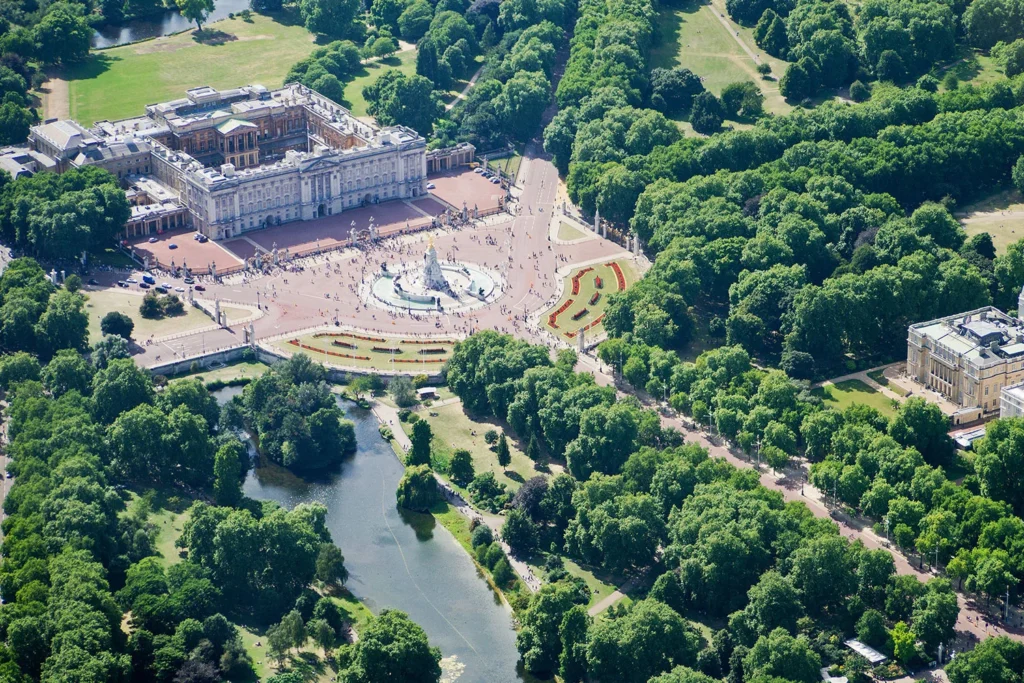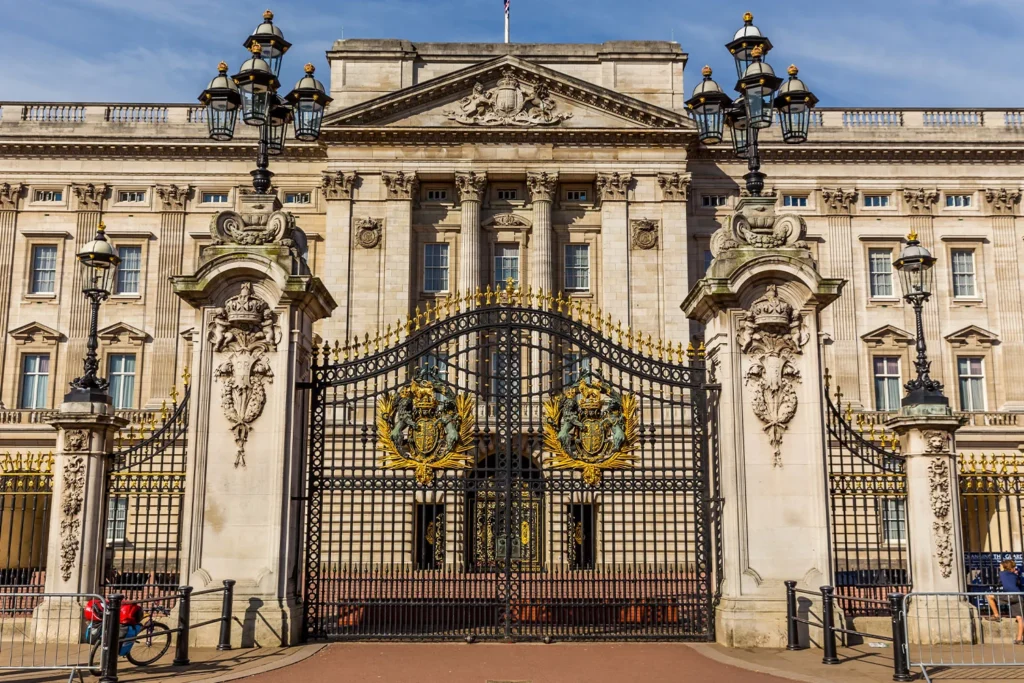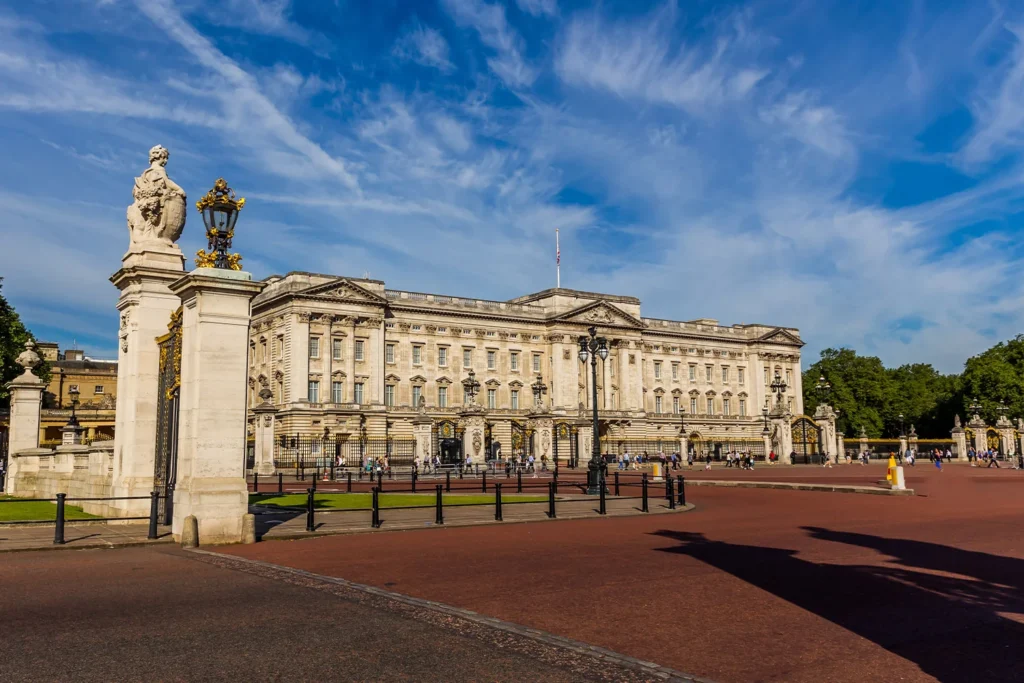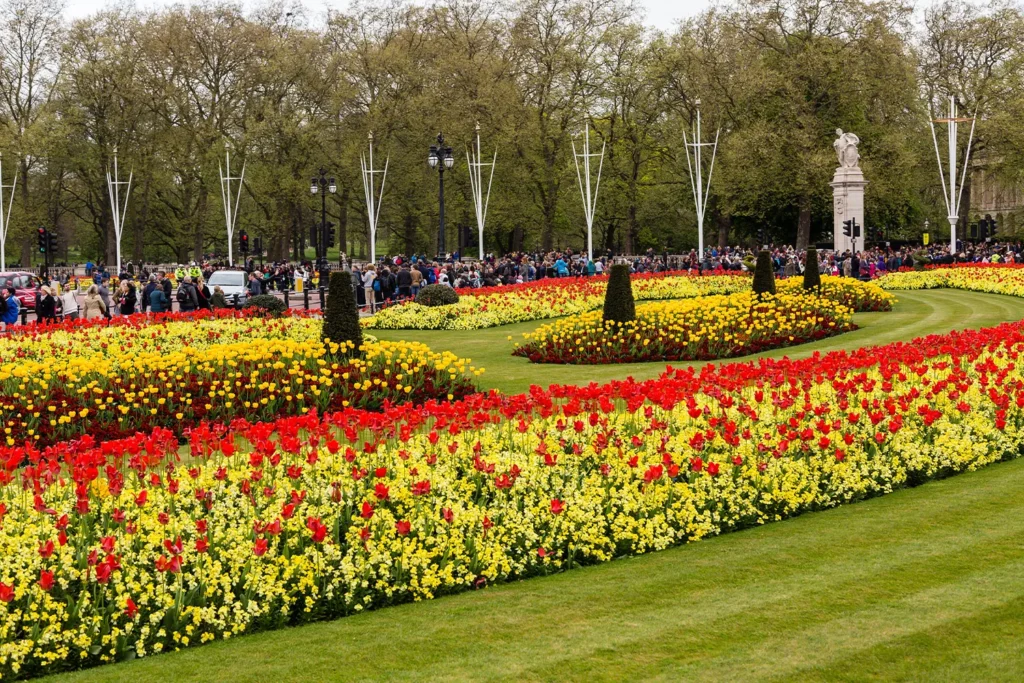Although this palace is one of many British royal residences, it is the only one recognized worldwide as the seat of the monarch and the center of both royal and state ceremonies.
Buckingham Palace, located in London, is one of the official residences of the British royal family. Although it is not the largest royal palace in the world, it can certainly be regarded as the most famous. While other royal estates, such as Windsor Castle or Kensington Palace, are equally stunning and grand, Buckingham Palace has become a globally recognized symbol of British monarchy. This beautiful building, standing in the City of Westminster, is a jewel of late Baroque architecture and occasionally opens its doors to the public, allowing visitors to marvel at its truly royal chambers.
Before Buckingham Palace was built…
The land where Buckingham Palace stands today was purchased by James I at the beginning of the 17th century. Contrary to what many might imagine, the land was not initially intended for the construction of a castle. James I established a mulberry plantation on the site for the cultivation of silkworms. The estate frequently changed hands until 1698, when it came into the possession of John Sheffield, later the Duke of Buckingham (hence the palace’s current name). It was at his initiative that Buckingham House, the first structure of the current royal residence, was built.
The building remained the property of the Dukes of Buckingham until 1762, when King George III purchased it with the intention of creating a residence for his wife, Queen Charlotte. However, it was still just a house. It wasn’t until George IV, son of George III, ascended the throne in 1820 that the transformation into a royal palace truly began. George IV took matters into his own hands and, with the help of the famous architect John Nash, designed an impressive U-shaped building—Buckingham Palace.
Unfortunately, the residence was not completed during George IV’s lifetime. His successor, William IV, showed little interest in either living in the palace or completing his predecessor’s project. His idea was to repurpose the space as a temporary seat for Parliament, a vision that was never realized. The offer was respectfully declined, and Parliament unanimously voted to complete and enhance the palace for royal use. Thanks to this decision, the building has served as the official residence of the monarchy since 1837.

GOOD TO KNOW: You may be wondering what happened to the idea of breeding silkworms. Initially, everything went according to plan, and it seemed like the king’s ambitious vision would come to fruition. Unfortunately, over time it was discovered that the wrong type of mulberry bush had been chosen, which ultimately caused the project to fail.
Visiting Buckingham Palace
If you want to see the living conditions of Queen Elizabeth or Queen Victoria, you can do so provided you visit London during the summer months (from July to September). It is only then, when the royal family is away on holiday, that the state rooms, gallery, and gardens are open to visitors. Sometimes tours are also organized in winter or spring, during the Easter and Christmas periods.
Regardless of the time that suits you best, tickets can and should be purchased in advance online (e.g., using the GetYourGuide platform). This way, you’ll avoid queues and ensure that your tour through the royal corridors actually takes place, as the number of daily entries is limited. But is it all worth the effort? You decide.

The total usable area of the building is 77,000 m². It houses as many as 775 rooms, although not all of them are open to the public. Out of these, 78 are bathrooms, 92 are offices, 188 are staff bedrooms, and 52 are royal and guest rooms. Finally, there are 19 state rooms, and it is these that can give you a glimpse into the secrets of royal life. Let’s take a look inside some of them…
State Rooms
It is in these public rooms of the palace that the monarch and members of the royal family receive guests during state and ceremonial events. Each of the 19 rooms is an exhibition space filled with antique furniture, valuable paintings, and items with a rich history. Among the treasures from the royal collection are paintings by Rembrandt, Van Dyck, and Canaletto, sculptures by Canova, and Sèvres porcelain.
It’s not just the masterpieces placed in these rooms that astonish visitors. The very appearance of the rooms impresses with every detail. Just a glance at the gilded decorations is enough to understand why John Nash, the principal architect, exceeded the planned budget…

GOOD TO KNOW: If you’re captivated by the treasures you see in Buckingham Palace’s rooms, be sure to also visit the Tower of London, where you can view the priceless Crown Jewels.
White Drawing Room
This is likely the most beautiful and recognizable of Buckingham Palace’s state rooms. It is famous for its hidden door behind a mirror, which connects this intricately decorated room to the neighboring, secret Royal Closet. The room has often been used as the backdrop for Christmas speeches and official family photos. And no wonder, as the yellow brocade upholstery, cut-glass chandeliers, and elegant white walls adorned with gilded ornaments create a truly regal setting.
Throne Room
As soon as you enter, you’ll notice the dramatic arch and canopy placed above the thrones, crafted for Queen Elizabeth II and Prince Philip in 1953. It’s immediately clear that John Nash, the designer of the room, had extensive experience in creating theatrical stage sets. However, these “Chairs of Estate” aren’t the only seats to see here. You’ll also spot the thrones made for the coronation of King George V and Queen Mary in 1911, as well as the most striking of them all, Queen Victoria’s single throne from 1837.
Ballroom
The largest of the state rooms, as its name suggests, originally housed a musicians’ gallery complete with an organ and was used for banquets and balls. Though its appearance has changed slightly from the original, it still hosts grand banquets and official ceremonies today.
If you were impressed by the seats in the Throne Room, just wait for this. The main feature of this room is another set of two thrones placed in a special alcove. These were crafted specifically for the coronation ceremony of King Edward VII and Queen Alexandra in 1902, and in my humble opinion, their charm can easily rival those in the Throne Room.
Music Room
This is the room where the current King Charles III was christened. However, the primary function of this room is somewhat different. It is typically where participants of royal family dinners or banquets are presented. Yet, to fall in love with this room, you don’t need to imagine the grand celebrations held here. Just take a moment to admire the striking blue columns, gilded arches, and the parquet floor made from exclusive types of wood, which has adorned the room since its completion in 1831.
Former Queen’s Gallery
Since 1962, this space was known as the place for storing and showcasing exceptional pieces from the Royal Collection. Today, the Queen’s Gallery is now the King’s Gallery, but it continues to serve the same purpose. Entering its interior, you’ll find rotating exhibitions that change every few months, featuring works by old masters, rare furniture, decorative arts, and photographs from the vast Royal Collection. Before your visit, you can check the exhibition schedule on this site.
Remember that to visit this gallery, you’ll need to purchase a special tour option called “A Royal Day Out,” which, in addition to the State Rooms, will grant you access not only to the gallery but also to the Royal Mews.
The Royal Mews
The Buckingham Palace stables, known as The Royal Mews, are responsible for every detail of the king’s and royal family’s land travel. With the right ticket, you can also explore this part of the palace. Inside, you’ll find not only stalls for horses but also coachmen’s uniforms and carriages. And these are no ordinary carriages, but those resembling the ones from princess fairy tales. The most magnificent is the Gold State Coach, a seven-meter-long carriage weighing a staggering four tons. It is adorned with gilded sculptures, including three cherubs on the roof representing England, Scotland, and Ireland, and four massive triton figures above each wheel.
The Buckingham Palace Gardens
This is the largest private garden in the capital of the United Kingdom. The 39-hectare area surrounding Buckingham Palace serves many purposes. It’s used for hosting official entertainment events and ceremonies. Within the grounds, there’s also a tennis court and a helicopter landing pad.

The main feature of the garden, however, is the 19th-century lake. Around it, various species of wild plants and over 1,000 trees are organized. If flowers are what touch your heart the most, make sure to visit the Royal Rose Garden. This Victorian section was established in the 1960s but continues to captivate romantics to this day.
The Changing of the Guard Ceremony
If the famously unpredictable English weather permits, crowds of tourists gather outside the palace at 11:00 a.m. to witness the Changing of the Guard ceremony. This is the moment when one regiment of soldiers takes over duties from the other. The New Guard, which during the ceremony becomes the Queen’s Guard, marches to Buckingham Palace from Wellington Barracks, accompanied by dignified musical accompaniment.

In theory, the Changing of the Guard takes place daily from April to July and every other day during the remaining months. However, it’s wise to check the official schedule on the British Army’s website, as it can change at any time, not only due to weather conditions. If you decide to watch this spectacle, make sure to arrive at the square in front of Buckingham Palace early, as it fills up incredibly quickly on sunny days.
FUN FACT: Before you start looking for His Majesty’s silhouette in the palace windows, check if the Royal Standard is flying in the wind. It is raised when the monarch is present at the palace. When the king is absent, it is lowered.
Practical information
- It is best to purchase tickets for Buckingham Palace in advance. This way, you can avoid standing in long lines and reduce the risk of tickets being sold out.
- Address: London SW1A 1AA, United Kingdom
- Buy tickets on GetYourGuide